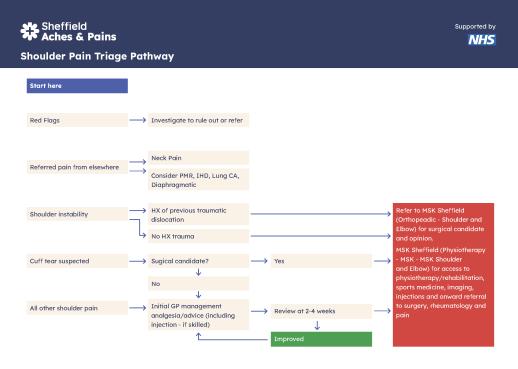Healthcare Professionals Hub
Shoulder
Pathway
Pathway definitions
Red Flags
- Tumor – history of cancer; symptoms and signs of cancer; unexplained deformity, mass, swelling or lymphadenopathy
- Infection – red skin, fever, systemically unwell
- Unreduced dislocation – trauma, epileptic fit, electric shock, loss of rotation, abnormal shape
- Acute rotator cuff tear – recent trauma, acute disabling pain and significant weakness, positive drop arm test
- Neurological lesion – unexplained wasting, significant sensory or motor deficit.
Referred pain from neck
- Test for focal pain in the neck, or pain that is reproduced by movement of the neck. Pain radiating distal to the elbow is more likely to be of neck origin than shoulder origin.
- Follow spinal pathway for treatment of neck pain.
Instability
Patient reports a subjective feeling of shoulder subluxation/dislocation with or without a history of injury or previous dislocation.
Rotator Cuff tears
- See also Red Flags above.
- Insidious or acute onset of shoulder pain (often patients point to the lateral deltoid area) associated with weakness of arm elevation or rotation.
- Examination reveals weakness of one or more of: abduction, external or internal rotation.
- A large discrepancy between poor active movements but reasonable passive movements often points to the cuff as a culprit and possible tear of significance if there has been trauma.
- USS by experienced radiologist is a reliable investigation to assess presence and size of tear. MRI scan is rarely required and indicated in primary care settings.
Surgical candidate for rotator cuff tear
There is no definite age limit to having surgery for a cuff tear. Suitability for surgical repair is based on medical comorbidities and patients ability to comply with postoperative rehabilitation.
All other shoulder pain
Includes:
- Rotator cuff related pain syndrome
- acromioclavicular joint pain
- Calcific tendon pain – radiograph required
- Adhesive capsulitis/Frozen shoulder – radiograph required
- OA of glenohumeral joint – radiograph required
Initial Gp management
- Patient centred assessment of biopsychosocial needs, and relevant treatment.
- Bio – Analgesia, advice to mobilise and appropriate advice about activity
- Psycho – Good explanation of diagnosis/ rule out of red flags, addressing concerns/ low mood.
- Social – Considering home and workplace factors likely to affect recovery , fit notes, occupational health involvement
- Reassess in timescale appropriate to patient needs.
Musculoskeletal team
Multidisciplinary team with access to a range of skills. Lead by senior physiotherapists skilled in shoulder management. To include access to joint injections, sports medicine advice, medical imaging (USS, xray, MRI).
Refer orthopaedic team
Patient to be offered choice of appropriate local providers of orthopaedic teams with expertise of managing shoulder conditions.
Referral to other specialist
- To consider Pain clinic. May include relieving injections (suprascapular nerve block)
- Rheumatology opinion – eg if inflammatory condition suspected
